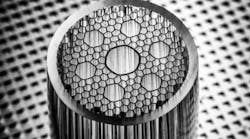lyntia, in collaboration with Nokia, LuxQuanta, ID Quantique, evolutionQ, OFS | Furukawa Solutions, and Digital Realty, conducted a proof of concept of quantum cryptography systems, also known as Quantum Key Distribution (QKD) in a real-world data center production network environment.
lyntia is leading this initiative, and the other partners are participating in this proof of concept. The manufacturers of QKD equipment, LuxQuanta and ID Quantique, evolved into QKD integrators, as did Nokia, which is responsible for DWDM equipment, and OFS | Furukawa Solutions, manufacturer of the "hollow core" fiber cable. Digital Realty also participated in the trial by providing the data center hosting the launch event.
The group's primary objective was to secure a fiber link from Digital Realty’s data center, a crucial step in demonstrating the compatibility of quantum cryptography with a new, very low-latency fiber technology.
Today, information is secured through asymmetric encryption protocols based on mathematical algorithms such as number factorization problems. While this approach was standard, the emergence of machine learning, artificial intelligence, and quantum computing threatens the security of this cryptographic approach.
Experts warn that the advent of quantum computers could render current cryptography, based on mathematical problems, vulnerable. This poses a serious risk to the security of all digital communications of large companies.
“The success of this quantum cryptography test demonstrates our position as a neutral operator, enabling our customers to implement their encryption systems with confidence, and reinforces our commitment to protecting data from future challenges,” said Eduardo Duato, CTO of lyntia.
Emerging approaches
Two new quantum-safe cryptographic alternatives have been developed to address the emerging security threat: Post-Quantum Cryptography (PQC) and Quantum Key Distribution (QKD). PQC is a software-based solution that employs complex mathematical algorithms to resist quantum computing attacks. However, since it relies on mathematical problems, there remains the possibility that future advancements could eventually solve these, potentially compromising its security.
For its part, India has driven this proof of concept, exploiting the second alternative: Quantum Key Distribution (QKD). QKD allows the secure exchange and generation of cryptographic symmetric keys between two locations, protecting them by the laws of quantum physics. This physical method does not rely on mathematical algorithms, offering a genuinely future-proof approach to information security that can be used alongside other cryptographic techniques to provide greater defense and resiliency.
During its test with critical partners, two versions of QKD technology from the two manufacturers LuxQuanta (CV-QKD) and ID Quantique (DV-QKD), along with a Quantum Key Management System (QKMS) from evolutionQ, were used to protect data center access connections. What’s critical about this technology is that it’s capable of providing cryptographic protection even against quantum computers.
Hollow core fiber’s role
Another key element of this trial was its use of hollow-core fiber technology. Hollow-core fibers guide light in a hollow core, making this unique waveguide ideal for sensing, imaging, and ultrashort pulse applications.
Earlier this year, lyntia via a partnership with Nokia, OFS | Furukawa Solutions and Digital Realty (Interxion) completed a field trial of hollow core fiber in Madrid.
LuxQuanta’s CV-QKD systems use the “Hollow-Core” fiber to secure a connection between the data center and the customer. A second deployment of QKD systems, Quantique, is made via conventional fiber from lyntia to extend the reach of the connection by several tens of kilometers.
With the hollow core fiber as the foundation, the collaboration culminated in integrating Nokia and evolutionQ systems, ensuring effective deployment orchestration. Nokia has provided high-capacity, low-latency encryption systems using quantum-secure keys to ensure in-flight data confidentiality alongside its certified geo-redundant Security Management Server (SMS) systems.
David Knight, Product Line Manager at OFS | Furukawa Solutions, said the collaboration shows the advantages of distributing quantum keys and the encrypted data stream.
“Successfully applying these technologies within a real-world data center interconnect proves their potential to enable future secure communications,” he said.
By continuously monitoring the Quantum-Safe optical data centers connectivity service, lyntia said the SMS could automatically ensure quantum-computer-safe connectivity by reverting to classic physics-based keys in the event of DDoS attacks on the QKD layer or failures in both key generation and distribution, resulting in highly available Quantum-Safe optical data center connectivity service.
EvolutionQ’s BasejumpQDN key system was no less important. It ensures efficient management of QKD keys between nodes and manages the delivery of these to Nokia’s encryptors at the right time.
The test allows the daisy-chaining of two QKD systems to transmit quantum keys over a longer distance over a production network, allowing them to reach longer distances of up to 200 kilometers with just one pair of devices. From now on, this transmission will be possible to more data centers as more equipment is installed.
Vanesa Díaz, CEO of LuxQuanta, said the trial shows the utility of quantum cryptography to secure optical links that connect data centers.
“We have showcased the interoperability of our product, NOVA LQ®, by integrating it with our partners’ systems and proving its ability to coexist in the same optical band as data, even over low-latency fibers,” she said. “This ensures secure and efficient transmission within existing optical networks.”
For related articles, visit the Business Topic Center.
For more information on high-speed transmission systems and suppliers, visit the Lightwave Buyer’s Guide.
To stay abreast of fiber network deployments, subscribe to Lightwave’s Service Providers and Datacom/Data Center newsletters.

